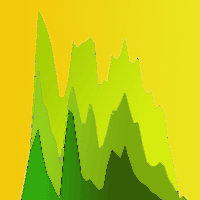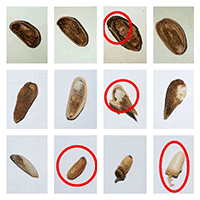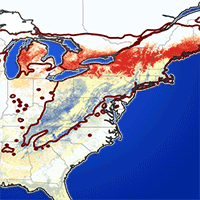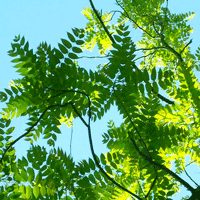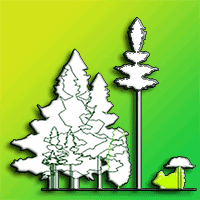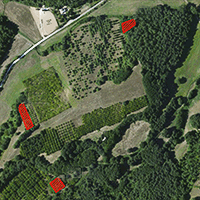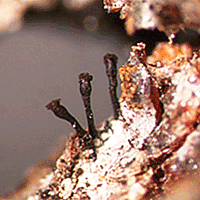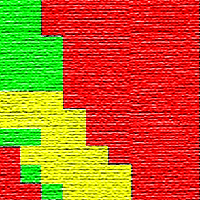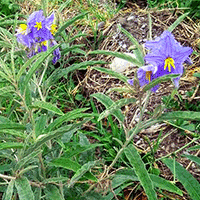Invasive pests are considered a major threat to biodiversity, conservation and agriculture. The Italian peninsula is a major site of intensive commercial exchange and transport of plants and goods, being consequently one of the European countries most invaded by alien insects. Hemiptera Coccomorpha are the largest group of non-native species recorded in Europe. For example, in the last 70 years more than 50 scale insect species have been accidentally introduced into Italy, 50% of which are now well established. This study was conducted to investigate the biology and the damage of the non-native pine tortoise scale Toumeyella parvicornis Cockerell (Hemiptera: Coccidae) accidentally introduced a few years ago into southern Italy. T. parvicornis is multivoltine in the invaded territories, being able to complete at least three generations per year, overwintering in the adult female stage. Oviposition periods during 2015-2017 surveys occurred from late April to end of May, from July to first half of August, and from mid-September to November. Fecundity was positively correlated to body size of gravid females and varied among the generations. Investigations on natural control by autochthonous species showed a seasonal activity of Metaphycus flavus (Hymenoptera: Encyrtidae), parasitizing mainly immature male individuals. The morpho-molecular approach confirms the hypothesis of an ongoing shift of parasitoid populations from other indigenous soft scales to the invasive one. Unfortunately, the low level of natural control was ineffective in hampering the spread of T. parvicornis, and preventing the dieback of local pine species, Pinus pinea, as observed in all invaded areas.
Keywords
, , , , ,
Citation
Garonna AP, Foscari A, Russo E, Jesu G, Somma S, Cascone P, Guerrieri E (2018). The spread of the non-native pine tortoise scale Toumeyella parvicornis (Hemiptera: Coccidae) in Europe: a major threat to Pinus pinea in Southern Italy. iForest 11: 628-634. - doi: 10.3832/ifor2864-011
Academic Editor
Massimo Faccoli
Paper history
Received: May 24, 2018
Accepted: Jul 13, 2018
First online: Oct 04, 2018
Publication Date: Oct 31, 2018
Publication Time: 2.77 months
© SISEF - The Italian Society of Silviculture and Forest Ecology 2018
Open Access
This article is distributed under the terms of the Creative Commons Attribution-Non Commercial 4.0 International (https://creativecommons.org/licenses/by-nc/4.0/), which permits unrestricted use, distribution, and reproduction in any medium, provided you give appropriate credit to the original author(s) and the source, provide a link to the Creative Commons license, and indicate if changes were made.

Breakdown by View Type
(Waiting for server response...)
Article Usage
Total Article Views: 48615
(from publication date up to now)
Breakdown by View Type
HTML Page Views: 39752
Abstract Page Views: 3942
PDF Downloads: 3890
Citation/Reference Downloads: 6
XML Downloads: 1025
Web Metrics
Days since publication: 2623
Overall contacts: 48615
Avg. contacts per week: 129.74
Article Citations
Article citations are based on data periodically collected from the Clarivate Web of Science web site
(last update: Mar 2025)
Total number of cites (since 2018): 18
Average cites per year: 2.25
Publication Metrics
by Dimensions ©
Articles citing this article
List of the papers citing this article based on CrossRef Cited-by.
(1)
Battisti A, Larsson S (2015)Climate change and insect pest distribution range. In: “Climate change and insect pests” (C. Björkman C, Niemelä P eds). CAB International, Wallingford, UK, pp. 1-15.
Online |
Gscholar
(2)
Camacho ER, Chong JH (2015)General biology and current management approaches of soft scale pests (Hemiptera, Coccidae). Journal of Integrated Pest Management 6 (1): 1-22.
CrossRef |
Gscholar
(3)
Camacho ER, Chong JH, Braman SK, Frank SD, Schultz PB (2017)Life history of
Parthenolecanium spp. (Hemiptera, Coccidae) in urban landscapes of the southeastern United States. Journal of Economic Entomology 110 (4): 1668-1675.
CrossRef |
Gscholar
(4)
Cascone P, Carpenito S, Slotsbo S, Iodice L, Srensen JG, Holmstrup M, Guerrieri E (2015)Improving the efficiency of
Trichogramma achaeae to control
Tuta absoluta. BioControl 60: 761-771.
CrossRef |
Gscholar
(5)
Castro-Guedes CF, Almeida LM (2017)Environmental impacts of arthropods as biological control agents. Oecologia Australis 21 (3): 268-279.
CrossRef |
Gscholar
(6)
Clarke SR (2013)Pine tortoise scale. USDA Forest Service, Forest Insect and Disease Leaflet 57: 1-8.
Gscholar
(7)
Cock MJW, Day RK, Hinz HL, Pollard KM, Thomas SE, Williams FE, Witt ABR, Shaw RH (2015)The impacts of some classical biological control successes. CAB Reviews 10: 042.
Gscholar
(8)
Cock MJW, Murphy ST, Kairo MTK, Thomson E, Murphy RJ, Francis AW (2016)Trends in the classical biological control of insect pests by insects, an update of the BIOCAT database. BioControl 61: 349-363.
CrossRef |
Gscholar
(9)
Cooper DD, Cranshaw W (2004)Seasonal biology and associated natural enemies of two
Toumeyella spp. in Colorado. Southwestern Entomologist 29 (1): 39-45.
Gscholar
(10)
Dale AG, Frank SD (2014)Urban warming trumps natural enemy regulation of herbivorous pests. Ecological Applications 24 (7): 1596-1607.
CrossRef |
Gscholar
(11)
Early R, Bradley BA, Dukes JS, Lawler JJ, Olden JD, Blumenthal DM, Gonzalez P, Grosholz ED, Ibanez I, Miller LP, Sorte CJB, Tatem AJ (2016)Global threats from invasive alien species in the twenty-first century and national response capacities. Nature Communications 7: 12485.
CrossRef |
Gscholar
(12)
Folmer O, Black M, Hoeh W, Lutz R, Vrijenhoek R (1994)DNA primers for amplification of mitochondrial cytochrome c oxidase subunit I from diverse metazoan invertebrates. Molecular Marine Biology and Biotechnology 3: 294-299.
Gscholar
(13)
García Morales M, Denno BD, Miller DR, Miller GL, Ben Dov Y, Hardy NB (2016)ScaleNet: a literature-based model of scale insect biology and systematics. On-line Database.
Online |
Gscholar
(14)
Garonna AP, Scarpato S, Vicinanza F, Espinosa B (2015)First report of
Toumeyella parvicornis (Cockerell) in Europe (Hemiptera, Coccidae). Zootaxa 3949 (1): 142-146.
CrossRef |
Gscholar
(15)
Green PWC, Hamilton MA, Sanchez MD, Corcoran MR, Manco BN, Malumphy CP (2015)The scope for using the volatile profiles of
Pinus caribaea var.
bahamensis as indicators of susceptibility to Pine Tortoise Scale and as predictors of environmental stresses. Chemistry and Biodiversity 12: 652-661.
CrossRef |
Gscholar
(16)
Green PWC, Hamilton MA, Sanchez MD, Fang R (2017)Phenotypic plasticity in the emission of terpenes by a threatened pine species (
Pinus caribaea var.
bahamensis), effects of scale infestation and environment. Forestry 90 (4): 553-560.
CrossRef |
Gscholar
(17)
Guerrieri E, Noyes JS (2000)Revision of European species of genus
Metaphycus Mercet (Hymenoptera, Chalcidoidea, Encyrtidae), parasitoids of scale insects (Homoptera, Coccoidea). Systematic Entomology 25 (2): 147-222.
CrossRef |
Gscholar
(18)
Guerrieri E, Giorgini M, Cascone P, Carpenito S, Van Achterberg C (2016)Species diversity in the parasitoid genus
Asobara (Hymenoptera, Braconidae) from the native area of the fruit fly pest
Drosophila suzukii (Diptera, Drosophilidae). PLoS One 11 (2): e0147382.
CrossRef |
Gscholar
(19)
Hajek AE, Hurley BP, Kenis M, Garnas JR, Bush SJ, Wingfield MJ, Van Lenteren JC, Cock MJW (2016)Exotic biological control agents, a solution or contribution to arthropod invasions. Biological Invasions 18 (4): 953-969.
CrossRef |
Gscholar
(20)
Hajibabaei M, Janzen DH, Burns JM, Hallwachs W, Hebert PDN (2006)DNA barcodes distinguish species of tropical Lepidoptera. Proceedings of the National Academy of Sciences USA 103: 968-971.
CrossRef |
Gscholar
(21)
Hebert PDN, Penton EH, Burns JM, Janzen DH, Hallwachs W (2004)Ten species in one, DNA barcoding reveals cryptic species in the neotropical skipper butterfly
Astraptes fulgerator. Proceedings of the National Academy of Sciences USA 101: 14812-14817.
CrossRef |
Gscholar
(22)
Inghilesi AF, Mazza G, Cervo R, Gherardi F, Sposimo P, Tricarico E, Zapparoli M (2013)Alien insects in Italy, comparing patterns from the regional to European level. Journal of Insect Science 13 (73): 1-13.
CrossRef |
Gscholar
(23)
Kalinkat G, Rall BC (2015)Effects of climate change on the interactions between insect pests and their natural enemies. In: “Climate change and insect pests” (C. Björkman C, Niemelä P eds). CAB International, Wallingford, UK, pp. 74-90.
CrossRef |
Gscholar
(24)
Kapranas A, Tena A (2015)Encyrtid parasitoids of soft scale insects, biology, behaviour, and their use in biological control. Annual Review of Entomology 60: 195-211.
CrossRef |
Gscholar
(25)
Kenis M, Hurley BP, Hajek AE, Cock MJW (2017)Classical biological control of insect pests of trees, facts and figures. Biological Invasions 19: 3401-3417.
CrossRef |
Gscholar
(26)
Kondo T, Pellizzari G (2011)Description of a new species of
Toumeyella Cockerell (Hemiptera, Coccidae) from Mexico, with a taxonomic key to Mexican species. Revista Brasileira de Entomologia 55 (2): 229-233.
CrossRef |
Gscholar
(27)
MacAloney HJ (1961)Pine tortoise scale. USDA Forest Service, Bromall, PA, USA, Forest Pest Leaflet 57: 1-7.
Gscholar
(28)
Malumphy C, Hamilton MA, Manco BN, Green PWC, Sanchez MD, Corcoran M, Salamanca E (2012)Toumeyella parvicornis (Hemiptera, Coccidae) causing severe decline of
Pinus caribaea var.
bahamensis in the Turks and Caicos Islands. Florida Entomologist 95: 113-119.
CrossRef |
Gscholar
(29)
Malumphy C, Hamilton MA, Sanchez MD, Green PWC (2016)Trapping confirms aerial recruitment of pine tortoise scale (
Toumeyella parvicornis Cockerell) (Hemiptera, Coccidae) in the Turks and Caicos Islands. Entomologist Monthly Magazine 152 (3): 193-200.
Online |
Gscholar
(30)
Mazzeo G, Longo S, Pellizzari G, Porcelli F, Suma P, Russo A (2014)Exotic scale insect (Coccoidea) on ornamental plants in Italy, a never-ending story. Acta Zoologica Bulgarica Suppl 6: 55-61.
Gscholar
(31)
Meineke EK, Dunn RR, Sexton JO, Frank SD (2013)Urban warming drives insect pest abundance on street trees. PLoS One 8(3): e59687.
CrossRef |
Gscholar
(32)
Miller GL, Williams ML (1990)Tests of male soft scale insects (Homoptera, Coccidae) from America north of Mexico, including a key to the species. Systematic Entomology 15 (3): 339-358.
CrossRef |
Gscholar
(33)
Myartseva SN, Ruíz-Cancino E, Coronado-Blanco JM, Refugio Lomelí-Flores J, Hernández-De la Cruz RC (2016)Parasitoids (Hymenoptera, Chalcidoidea) of
Toumeyella scales (Hemiptera, Coccidae) in the New World, with description of a new species from Mexico. Florida Entomologist 99 (4): 781-784.
CrossRef |
Gscholar
(34)
Noyes JS (1982)Collecting and preserving chalcid wasps (Hymenoptera, Chalcidoidea). Journal of Natural History 16: 315-334.
CrossRef |
Gscholar
(35)
Noyes JS (2003)Universal Chalcidoidea Database . Web site.
Online |
Gscholar
(36)
Orr DW (1931)Studies on the natural
vs. artificial control of the pine tortoise scale. Minnesota Agricultural Experimental Station Bulletin 79: 1-19.
Gscholar
(37)
Pellizzari G, Dalla Montà L, Vacante V (2005)Alien insect and mite pests introduced to Italy in sixty years (1945-2004). In: “Plant protection and plant health in Europe, introduction and spread of invasive species” (Alford DV, Backhaus GF eds). British crop production council, Alton, UK, pp. 275-276.
Online |
Gscholar
(38)
Rabkin FB, Le Jeune RR (1954)Some aspects of the biology and dispersal of the pine tortoise scale (
Toumeyella numismaticum Pettit and McDaniel) (Homoptera, Coccidae). The Canadian Entomologist 86: 570-575.
CrossRef |
Gscholar
(39)
Roques A (2010)Taxonomy, time and geographic patterns. BioRisk 4: 11-26.
CrossRef |
Gscholar
(40)
Roques A, Auger-Rozenberg MA, Blackburn TM, Garnas J, Pyšek P, Rabitsch W, Richardson DM, Wingfield MJ, Liebhold AM, Duncan RP (2016)Temporal and interspecific variation in rates of spread for insect species invading Europe during the last 200 years. Biological Invasions 18: 907-920.
CrossRef |
Gscholar
(41)
Schulmeister S (2003)Simultaneous analysis of basal Hymenoptera (Insecta), introducing robust-choice sensitivity analysis. Biological Journal of the Linnean Society 79: 245-275.
CrossRef |
Gscholar
(42)
Segarra-Carmona AE, Cabrera-Asencio I (2010)Toumeyella parvicornis (Cockerell) (Hemiptera, Coccoidea, Coccidae), a new invasive pest of pine trees in Puerto Rico. Journal of Agriculture University of Puerto Rico 94: 175-177.
Online |
Gscholar
(43)
Sheffer BJ, Williams ML (1990)Descriptions, distribution, and host-plant records of eight first instars in the genus
Toumeyella (Homoptera, Coccidae). Proceedings of the Entomological Society of Washington 92 (1): 44-57.
Online |
Gscholar
(44)
Simon C, Frati F, Beckenbach A, Crespi B, Liu H, Flook P (1994)Evolution, weighting, and phylogenetic utility of mitochondrial gene sequences and a compilation of conserved polymerase chain reaction primers. Annals of the Entomological Society of America 87 (6): 651-701.
CrossRef |
Gscholar
(45)
Stouthamer R, Hu J, Van Kan FJPM, Platner GR, Pinto JD (1999)The utility of internally transcribed spacer 2 DNA sequences of the nuclear ribosomal gene for distinguishing sibling species of
Trichogramma. BioControl 43: 421-440.
CrossRef |
Gscholar
(46)
Van Driesche RG, Hoddle MS (2016)Non-target effects of insect biocontrol agents and trends in host specificity since 1985. CABI Reviews 11: 044.
CrossRef |
Gscholar
(47)
Viggiani G, Guerrieri E (1988)Le specie italiane del genere
Metaphycus Mercet (Hymenoptera Encyrtidae). [The Italian species of the genus
Metaphycus Mercet (Hymenoptera Encyrtidae)] Bollettino del Laboratorio di Entomologia Agraria “Filippo Silvestri”, Portici, Naples, Italy, vol. 45, pp. 113-139. [in Italian]
Gscholar
(48)
Williams ML, Kondo T (2008)Status and current composition of the soft scale insect genus
Toumeyella (Hemiptera, Coccoidea). In: Proceedings of the “11th International Symposium on Scale Insect Studies” (Branco M, Franco JC, Hodgson C eds). ISA Press, Lisbon, Portugal, pp. 29-32.
Gscholar
(49)
Williams M, Kosztarab M (1972)Morphology and systematics of the Coccidae of Virginia with notes on their biology (Homoptera, Coccoidea). Virginia Polytechnic Institute Research Division Bulletin 74: 1-215.
Gscholar
